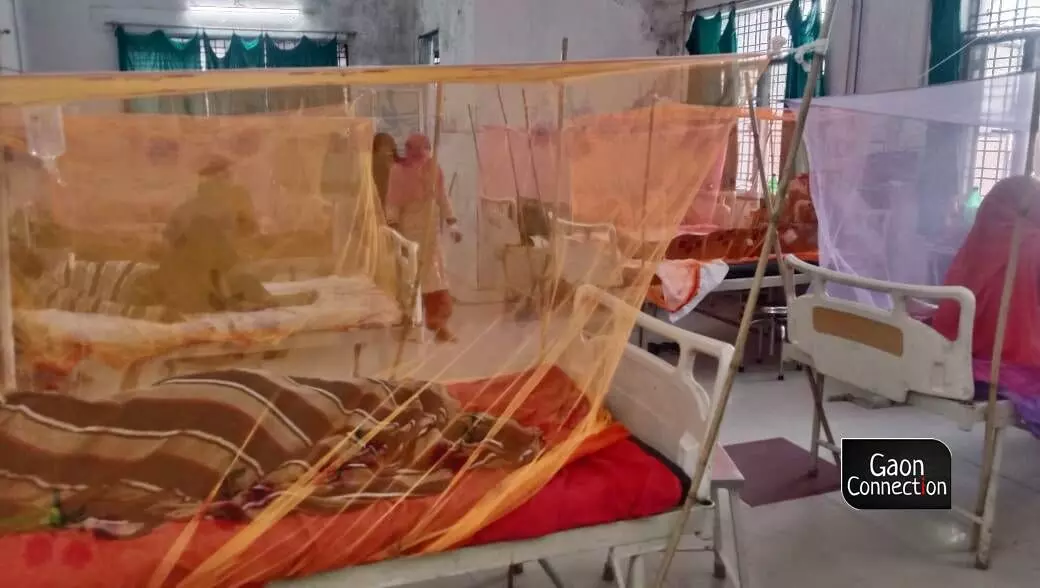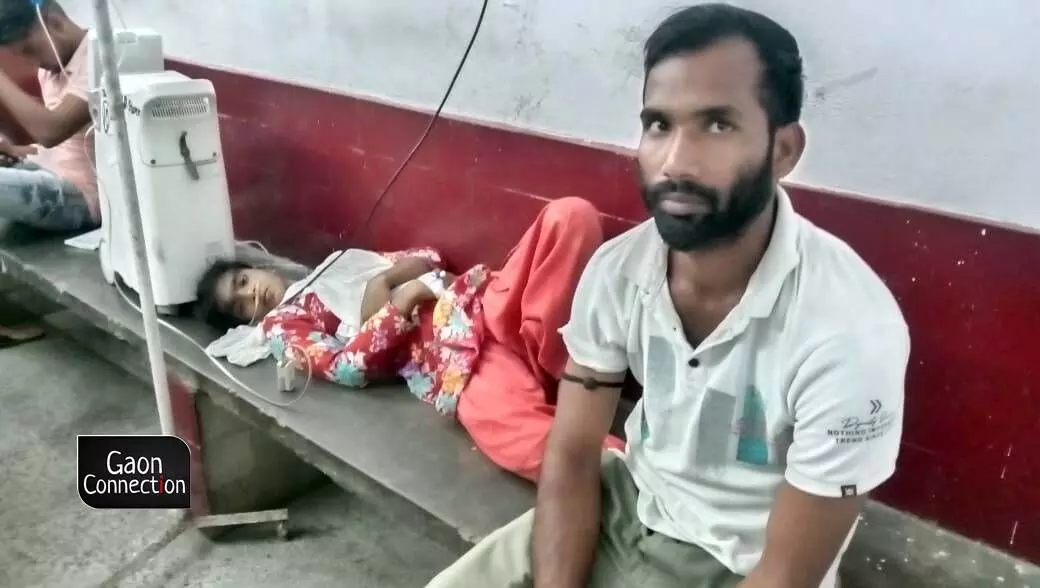Barabanki/Sitapur
On October 10, Chiraiya village in Barabanki district of Uttar Pradesh wore a desolate look as silent mourners stood outside the home of Priyanshi, a six-year-old, who had died of a fever.
“When we took her to Shraddha Hospital in Barabanki, there was a crowd of people there and we couldn’t get her admitted as there were no beds available. We then took her to a private hospital in Lucknow, but we could not save her life,” Phool Raj, the 40-year-old uncle of Priyanshi, told Gaon Connection.
Priyanshi died of internal bleeding in her lungs. She was amongst dozens of children in her village who were laid low with fever.
“The entire village is down with fever. There’s hardly any household without a family member who is unwell. My five-year-old son is also having a fever. I fear for his life now, seeing Priyanshi like this scares me…,” Savitri Devi, a resident of Chiraiya village told Gaon Connection.
“I have never seen such an outbreak of dengue, malaria and fever in the village before,” she added. Village after village in Barabanki, Sitapur and Shahjahanpur districts are witnessing a crisis like never before.
Also Read: Malaria Rears its Head in Rural Uttar Pradesh; Deaths Due to ‘Fever’ Being Reported
Things have taken a turn for the worse because of inadequate medical support in the villages. Devi, for instance Devi is getting her son treated by a jholachhap doctor [rural health practitioner] in Belhara town.
“The samudaayik swasthya kendra [community health centre] is 15 kilometres away and the district hospital is about 40 kilometres away. My relatives told me that it is crowded with people. So, I prefer to get my son treated in Belhara itself,” she said.

An ASHA worker who was at the district hospital at Barabanki to get her son treated for dengue, said she had never encountered so many fever cases in her village at the same time before.
Avneesh Chaudhary, who is in charge of the community health centre in Barabanki’s Fatehpur block acknowledged that there was a surge in the number of patients.
“Patients are showing up with various types of fevers. There’s dengue, typhoid, and malaria. We have sent teams to the villages to distribute medicines and test the people for infections,” Chaudhary told Gaon Connection.
Meanwhile, according to DK Srivastava, the upper chief medical officer in Barabanki district, test facilities to detect malaria and dengue are available across the seven CHCs in the district.
“A change of season is also responsible for the surge in cases. I would like to appeal to the villagers to seek treatment at the CHCs rather than the district hospital as it is already overburdened. Patients lose out on critical time because of the time spent in travelling to distant city hospitals when they can be treated at the local health centres,” Srivastava told Gaon Connection.
Also Read: An ‘unknown fever’ in Uttar Pradesh’s Sitapur claims 20 lives, 2,000 hit
From October 17, teams of ASHA workers [accredited social health activists] will visit the villages to check for dengue and malaria cases and ensure that there are no stagnant pools of water in the villages that can become a breeding ground for mosquitoes.

Village after village in Barabanki, Sitapur and Shahjahanpur districts are witnessing a crisis like never before.
An ASHA worker who was at the district hospital at Barabanki to get her son treated for dengue, said she had never encountered so many fever cases in her village at the same time before.
“Every other house has someone with fever. My son has dengue too,” Reshma Devi, the ASHA from Chandauli village, told Gaon Connection.
‘Number of patients increased by thrice’
About 100 kilometres away from the district hospital in Barabanki, a doctor working at the community health centre in Shahjhanpur’s Sindhauli block told Gaon Connection that the number of patients had almost tripled.
“On an average there were about 300 people visiting the centre for treatment every day. For the past two weeks, the number has surged to more than 800 patients. We are equipped to treat dengue and malaria cases. There was a patient of dengue admitted here but we have referred him to the district hospital now,” Gaurav Saxena, a junior resident doctor at the health centre told Gaon Connection.
“Districts such as Lucknow, Unnao, Barabanki, Sitapur, and Shahjahanpur are known for outbreaks of vector borne diseases in September-October,” Rohtas Kumar, the chief medical officer of Hardoi district told Gaon Connection.
“We are stocked up on medicines to deal with dengue or malaria and the district administration is ready for any major outbreak. I am aware that Barabanki district is facing a huge crisis and we are ready to respond if a similar problem arises in Shahjahanpur,” Kumar said.
In Badaun district, the chief medical officer stated that such spikes in cases of fever are an annual affair but the administration has already reserved hospital beds to stay prepared in advance.
“The CHCs have been instructed to keep at least five beds ready for a spike in fever cases and the district hospital has 30 such beds ready,” Pradip Varshney, Badaun CMO, told Gaon Connection.
Similar arrangements have been made in Mirzapur district where 60 beds have been dedicated for dengue patients at the Maa Vindhyavasini Autonomous State Medical College.
“At least 1,200 patients complaining of high fever are coming to this hospital. The symptoms include stomach ache, coughing, sneezing, cold, and body ache,” RB Kamal, the principal of the medical college told Gaon Connection.




















